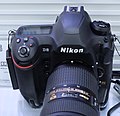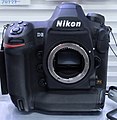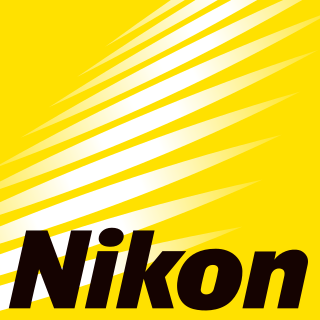
Nikon Corporation is a Japanese optics and photographic equipment manufacturer headquartered in Tokyo, Japan. The companies held by Nikon form the Nikon Group.
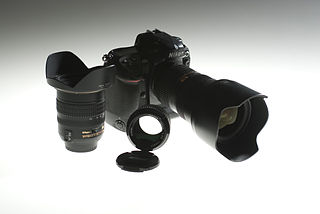
The Nikon D2X is a 12.4-megapixel professional digital single-lens reflex camera (DSLR) that Nikon Corporation announced on September 16, 2004. The D2X was the high-resolution flagship in Nikon's DSLR line until June 2006 when it was supplanted by the D2Xs and, in time, the Nikon D3 range, Nikon D4 range, the Nikon D5 and the Nikon D6— the latter four using a FX full-format sensor.

A digital single-lens reflex camera is a digital camera that combines the optics and the mechanisms of a single-lens reflex camera with a solid-state image sensor and digitally records the images from the sensor.
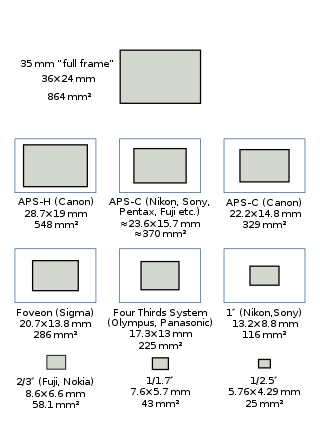
A full-frame DSLR is a digital single-lens reflex camera (DSLR) with a 35 mm image sensor format. Historically, 35 mm was one of the standard film formats, alongside larger ones, such as medium format and large format. The full-frame DSLR is in contrast to full-frame mirrorless interchangeable-lens cameras, and DSLR and mirrorless cameras with smaller sensors, much smaller than a full 35 mm frame. Many digital cameras, both compact and SLR models, use a smaller-than-35 mm frame as it is easier and cheaper to manufacture imaging sensors at a smaller size. Historically, the earliest digital SLR models, such as the Nikon NASA F4 or Kodak DCS 100, also used a smaller sensor.

The Nikon D3 is a 12.0-megapixel professional-grade full frame (35 mm) digital single lens reflex camera (DSLR) announced by the Nikon Corporation on 23 August 2007 along with the Nikon D300 DX format camera. It was Nikon's first full-frame DSLR. The D3, along with the Nikon D3X, was a flagship model in Nikon's line of DSLRs, superseding the D2Hs and D2Xs. It was replaced by the D3S as Nikon's flagship DSLR. The D3, D3X, D3S, D4, D4s, D5, D6, D700, D800, D800Е and Df are the only Nikon FX format DSLRs manufactured in Japan. The D3S was replaced by the D4 in 2012.

The Nikon D3S is a 12.1-megapixel professional-grade full frame (35mm) digital single-lens reflex camera (DSLR) announced by Nikon Corporation on 14 October 2009. The D3S is the fourth camera in Nikon's line to feature a full-frame sensor, following the D3, D700 and D3X. It is also Nikon's first full-frame camera to feature HD (720p/30) video recording. While it retains the same number of pixels as its predecessor, the imaging sensor has been completely redesigned. Nikon claims improved ultra-high image sensor sensitivity with up to ISO 102400, HD movie capability for extremely low-lit situations, image sensor cleaning, optimized workflow speed, improved autofocus and metering, enhanced built-in RAW processor, quiet shutter-release mode, up to 4,200 frames per battery charge and other changes compared with the D3. It was replaced by the D4 as Nikon's high speed flagship DSLR.

The Nikon D7000 is a 16.2-megapixel digital single-lens reflex camera (DSLR) model announced by Nikon on September 15, 2010. It replaced the D90 as the top end consumer camera, by using much of the technology and controls from the earlier D5000, in a larger more robust body similar to the flagship D300 series. In some ways it was superior to the D300S, though for several years the two cameras were both available with the D300 positioned as the flagship in Nikon marketing materials.

The Nikon D5100 is a 16.2-megapixel DX-format DSLR F-mount camera announced by Nikon on April 5, 2011. It features the same 16.2-megapixel CMOS sensor as the D7000 with 14-bit depth, while delivering Full HD 1080p video mode at either 24, 25 or 30fps. The D5100 is the first Nikon DSLR to offer 1080p video at a choice of frame rates; previous Nikon DSLRs that recorded 1080p only did so at 24 fps. It replaced the D5000 and was replaced by the D5200.

The Nikon D4 is a 16.2-megapixel professional-grade full frame (35mm) digital single-lens reflex camera (DSLR) announced by Nikon Corporation on 6 January 2012. It succeeds the Nikon D3S and introduces a number of improvements including a 16.2 megapixel sensor, improved auto-focus and metering sensors and the ability to shoot at an extended ISO speed of 204,800. The camera was released in February 2012 at a recommended retail price of $5999.95. It is the first camera to use the new XQD memory cards. It was replaced by the Nikon D4S as Nikon's flagship camera.

The Nikon Expeed image/video processors are media processors for Nikon's digital cameras. They perform a large number of tasks: Bayer filtering, demosaicing, image sensor corrections/dark-frame subtraction, image noise reduction, image sharpening, image scaling, gamma correction, image enhancement/Active D-Lighting, colorspace conversion, chroma subsampling, framerate conversion, lens distortion/chromatic aberration correction, image compression/JPEG encoding, video compression, display/video interface driving, digital image editing, face detection, audio processing/compression/encoding and computer data storage/data transmission.

The Nikon D5200 is an F-mount DSLR camera with a newly developed 24.1-megapixel DX-format CMOS image sensor first announced by Nikon on November 6, 2012 for most of the world and January 7, 2013 for the North American market.

The Nikon D7100 is a 24.1-megapixel digital single-lens reflex camera model announced by Nikon in February 2013. It is a 'prosumer' model that replaces the Nikon D7000 as Nikon's flagship DX-format camera, fitting between the company's entry-level and professional DSLR models. This camera is the first ever from Nikon with no optical low-pass filter incorporated. At launch, Nikon gave the D7100 estimated selling price in the United States as US$ 949.95 for the body.

The Nikon D4S is a full frame professional DSLR camera announced by Nikon Corporation on February 25, 2014 to succeed the D4 as its flagship DSLR. The D4S offers a number of improvements over its predecessor including a new image sensor, new image processor, new battery, improved ergonomics and expanded ISO range. Additionally, improved auto focus (AF) algorithms and a new AF Tracking mode were introduced together with a new option of RAW image capture in full resolution or a "Small" file.

The Nikon D750 is a full-frame DSLR camera announced by Nikon on September 12, 2014. It is an extensive upgrade from the D610, but with the same general body and control characteristics, along with 24 megapixel resolution. Despite the 7, there is little relationship with the D700, which was the precursor to the D800. The D600 and D610 evolved as a full-frame consumer cameras with similar structure and controls to the D7000 series of cropped frame cameras. The D750 shares similar structure and controls with the cropped-frame D7500.

The Nikon D500 was a 20.9-megapixel professional digital single-lens reflex camera with an APS-C sensor. It was announced by Nikon Corporation on January 6, 2016 along with the Nikon D5 full frame camera. D500 replaced the D300S as Nikon's DX format flagship DSLR. On February 23, 2017, at CP+ show, a special edition was released for Nikon's 100th anniversary. The D500 jointly won a Camera Grand Prix Japan 2017 Editors Award. The camera was discontinued on February 1, 2022.

The Nikon D5 is a full frame professional DSLR camera announced by Nikon Corporation on 6 January 2016 to succeed the D4S as its flagship DSLR. The D5 offers a number of improvements over its predecessor including a new image sensor, new image processor, improved ergonomics and expanded ISO range. Additionally, improved auto focus (AF) mode were introduced. On 23 February 2017, at CP+ show, a special edition was released for Nikon's 100th anniversary.

The Nikon D5600 is a 24.2 megapixel upper-entry level, APS-C sensor DSLR announced by Nikon on November 10, 2016, as the successor of the D5500. The camera has an F-mount.

The Nikon D7500 is a 20.9-megapixel digital single-lens reflex camera using an APS-C sensor. It was announced by Nikon Corporation on 12 April 2017, and started shipping on 2 June 2017. It is the successor to the Nikon D7200 as Nikon's DX format midrange DSLR.
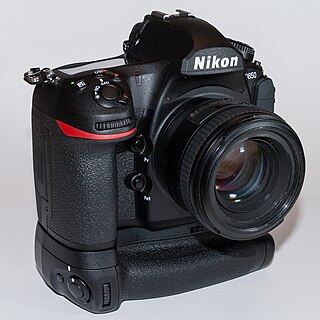
The Nikon D850 is a professional-grade full-frame digital single-lens reflex camera (DSLR) produced by Nikon. The camera was officially announced on July 25, 2017, launched on August 24, 2017, and first shipped on September 8, 2017. Nikon announced it could not fill the preorders on August 28, 2017 and filled less than 10% of preorders on the first shipping day. It is the successor to the Nikon D810.

The Nikon Z 9 is a full-frame mirrorless camera produced by Nikon. The camera was announced on October 28, 2021.


